Wheelchair Skills Education and Training for Children with Spina Bifida and/or Hydrocephalus and Their Parents: A Pilot Study
Abstract
1. Introduction
- (1)
- To develop and evaluate a wheelchair skills information pack.
- (2)
- To investigate the impact of training on children’s performance of wheelchair skills.
- (3)
- To explore parents’ perspectives on how training has influenced children’s daily participation.
- (4)
- To identify beneficial aspects of program delivery for children and parents.
2. Materials and Methods
2.1. Study Design
2.2. Participants
2.3. Study Procedure, Timeline and Data Collection
2.3.1. Pre-Training Program
Wheelchair Skills Training Information Pack Content
Images and Graphic Design for Accessibility
2.3.2. Introducing the Training Program and the Photovoice Method
2.3.3. Pre- and Post-Training Measures
Demographic Questionnaire
Wheelchair Skills Information Pack and Open-Ended Questionnaire
2.3.4. Training Program Evaluation
Baseline Data
Evaluation Data
2.4. Data Analysis
2.5. Ethics
3. Study Findings
3.1. Demographic Data
3.2. Objective 1: Evaluation of the Wheelchair Skills Training Information Pack
3.3. Objective 2: Pre-/Post-Wheelchair Skills Test (WST) Findings
3.4. Objective 3: Parents’ Perspectives on How Training Influenced Children’s Daily Participation
“Obviously again they are all at different ages and stages and abilities and all the rest of it. I thought the one-on-one was brilliant.”Aine
“It is always great to see someone who can use their wheelchair independently and I think it is great for kids to see that, you know, to see that …, you can just go and do it.”Elaine
3.4.1. Photovoice T1 Findings: Elaine and Sally
“Sally would have just driven at the step and forced the chair over it with a risk of damaging the chair and getting hurt herself; she is now able to roll her chair backwards and forwards to navigate changes in level.”
“I was amazed—really we went a good distance into the forest…she was able to do it herself, doing the tip back and forward to get over the bed and bits of roots sticking over the ground.”Elaine
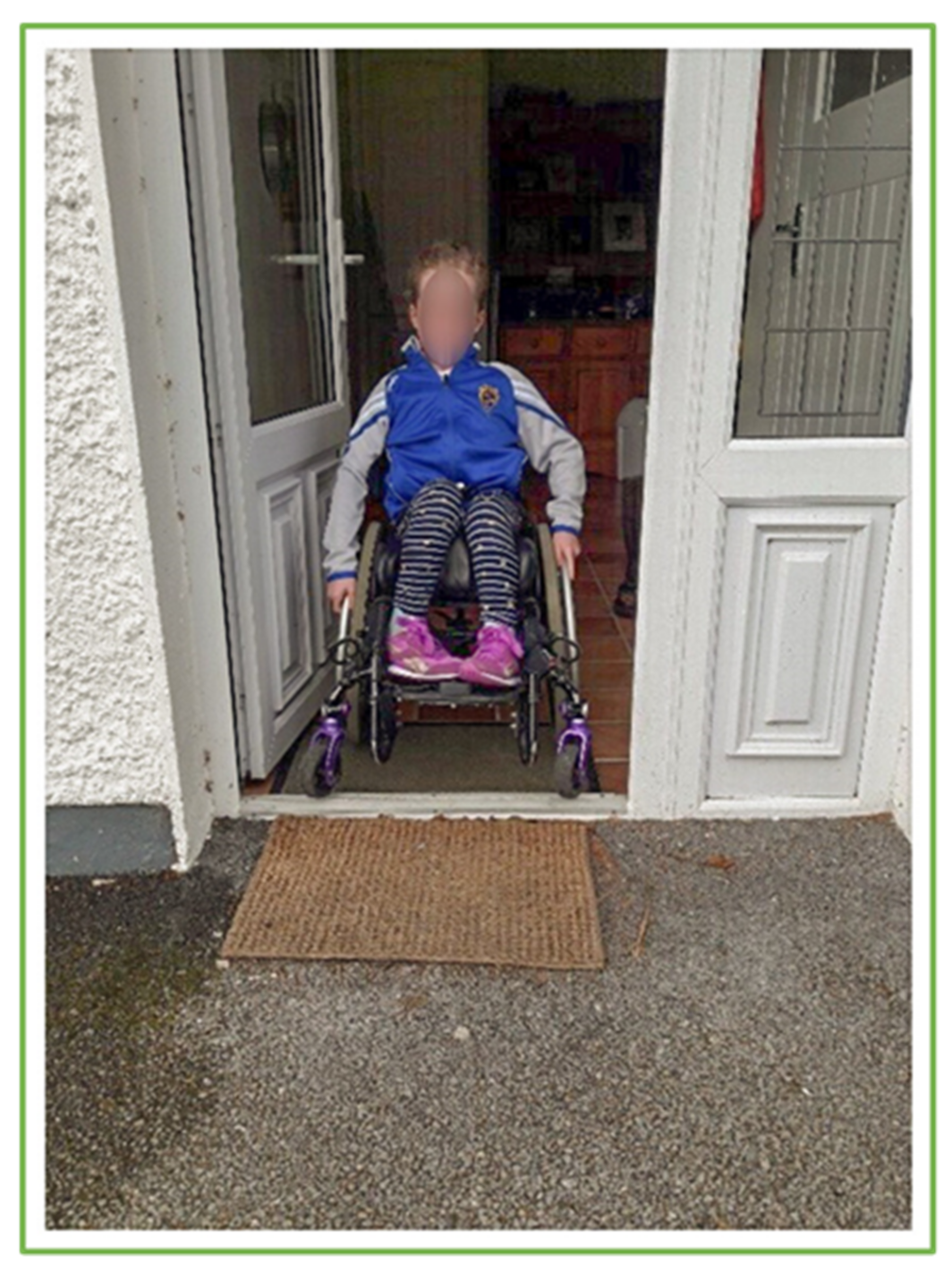
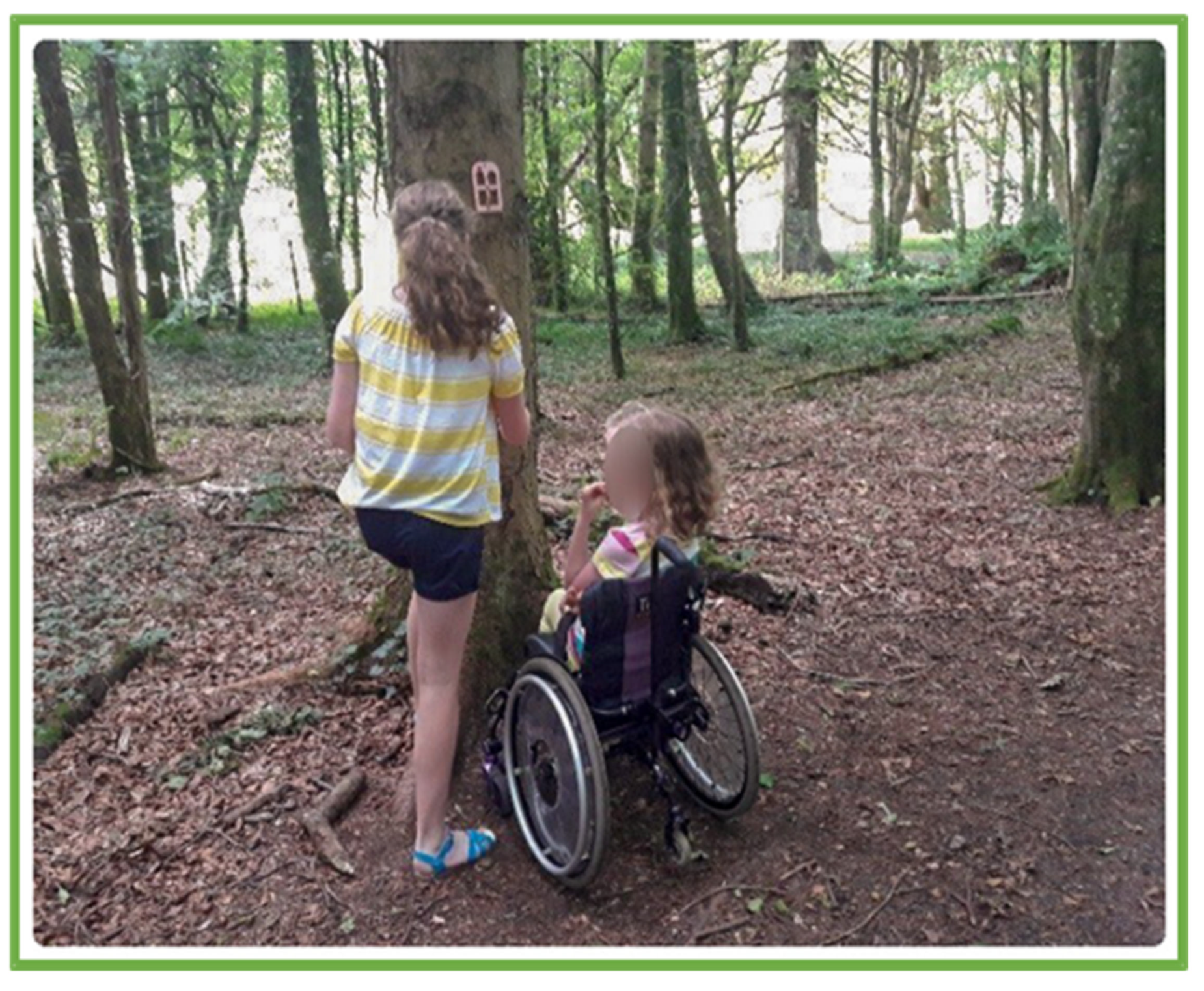
3.4.2. Photovoice T1 Findings: Emily and Joanne
“She was determined to do it and was not happy until she succeeded.
“Now she just disappears in the house at times; she would be gone into one of the rooms and hiding.”
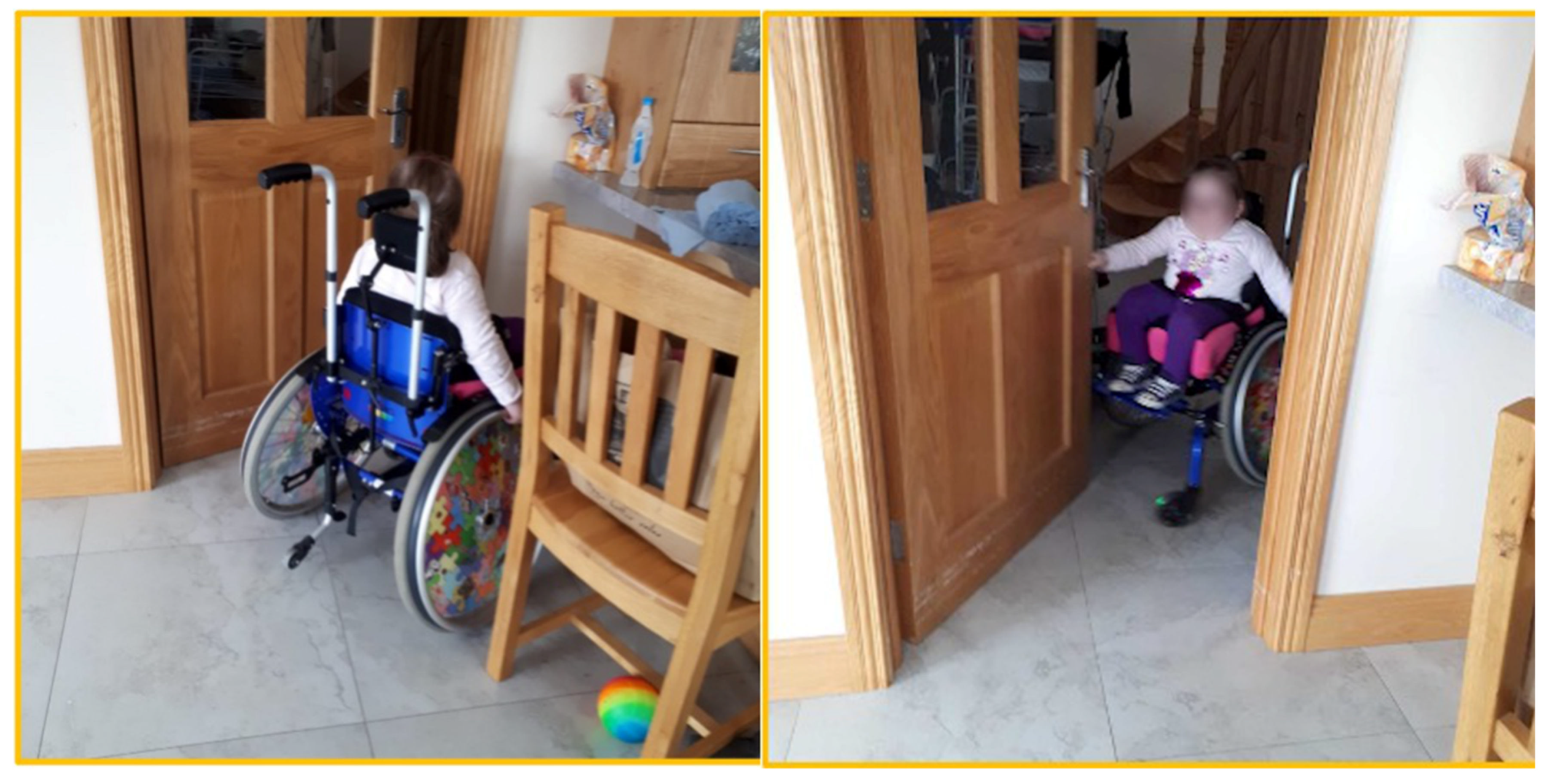
3.4.3. Photovoice T1 Findings: Jackie
“She would drive the wheelchair straight up and kind of throw herself out.”
“Pop out of the wheelchair”
“When she got the transfer right, she was pure delighted with herself.”
3.4.4. Photovoice T1 Findings: Aine and James
“contributed to giving him the right patterns from a very early age, that you know he will build on those
| Skill | Comment and Plan |
|---|---|
| Rolling Forward (second session) | Follow the leader |
| Rolling backward (second session) | Follow the leader |
| Object negotiation (second session) | Mats set up to drive through |
| Reaching (second session) | Ball/bean bag toss |
| Turning (second session) | Navigating tight spaces (not sideways) |
| Object manipulation (third session) | Basketball—hold ball with one hand and propell with the other, then alternate |
| Forward propulsion (third session) | Choo choo train—emphasized leaning forward |
| Turns in circle (third session) | Chasing Dad forward and around trainer |
| Navigating tight spaces (third session) | Forward only through obstacles—90°/180° turns |
| Thresholds (third session) | Open door and over threshold |
| Soft surfaces (third session) | Mat and grass forward and backwards |
“Leaning forward going up the hill—he is doing that and even coming down the hill he will say ‘lean back’, so he is saying it and doing it.”
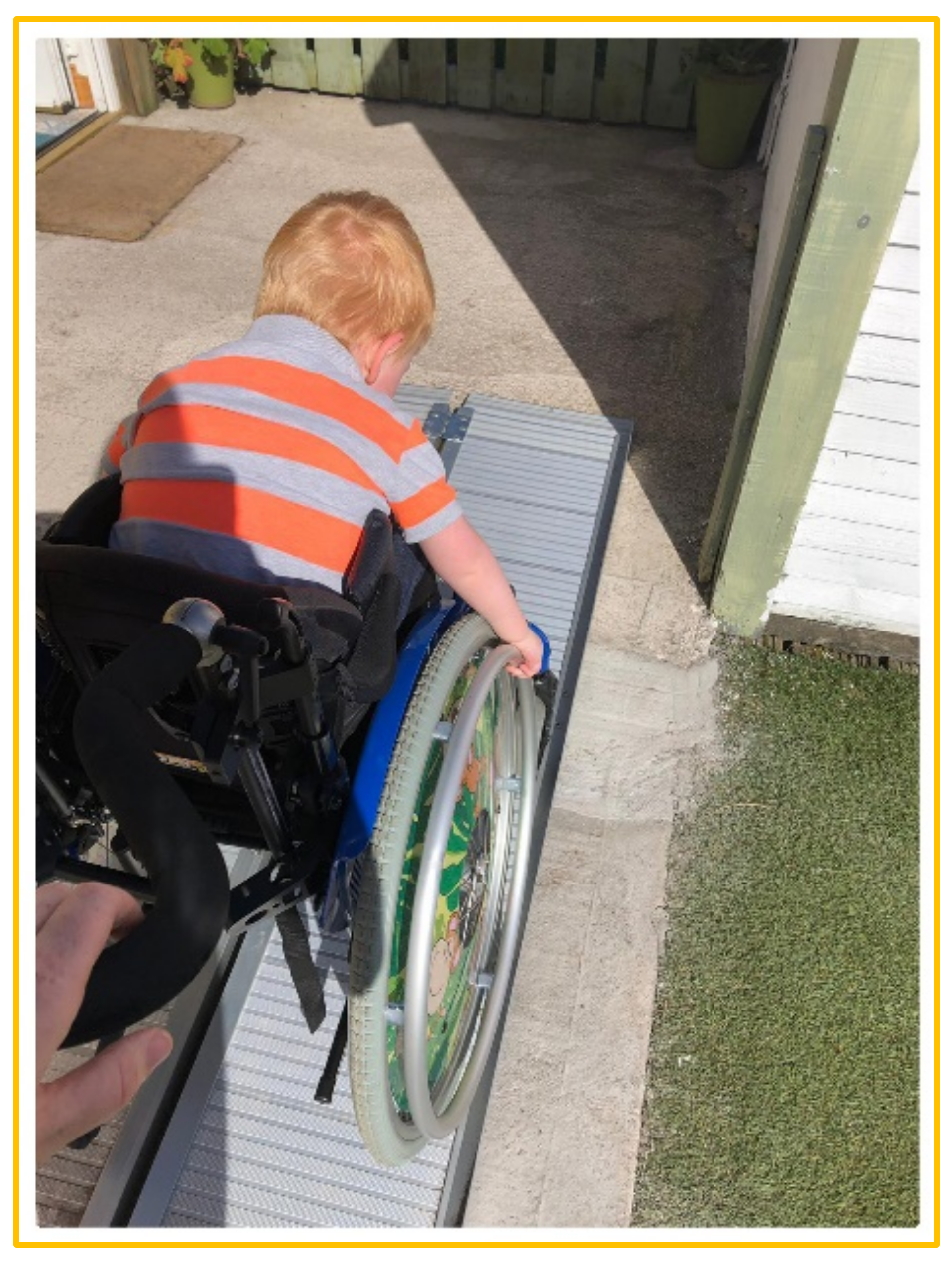
3.5. Objective 4: Beneficial Aspects of the Program
“She could see, and I could see, so when we are at home, I could say, so remember when (instructors name) did X, Y, Z. I think that was the best part of it.”Elaine
“We are trying to get her to lift the wheels to come in over it, but she is not really getting that one yet, but we will keep trying”Liz
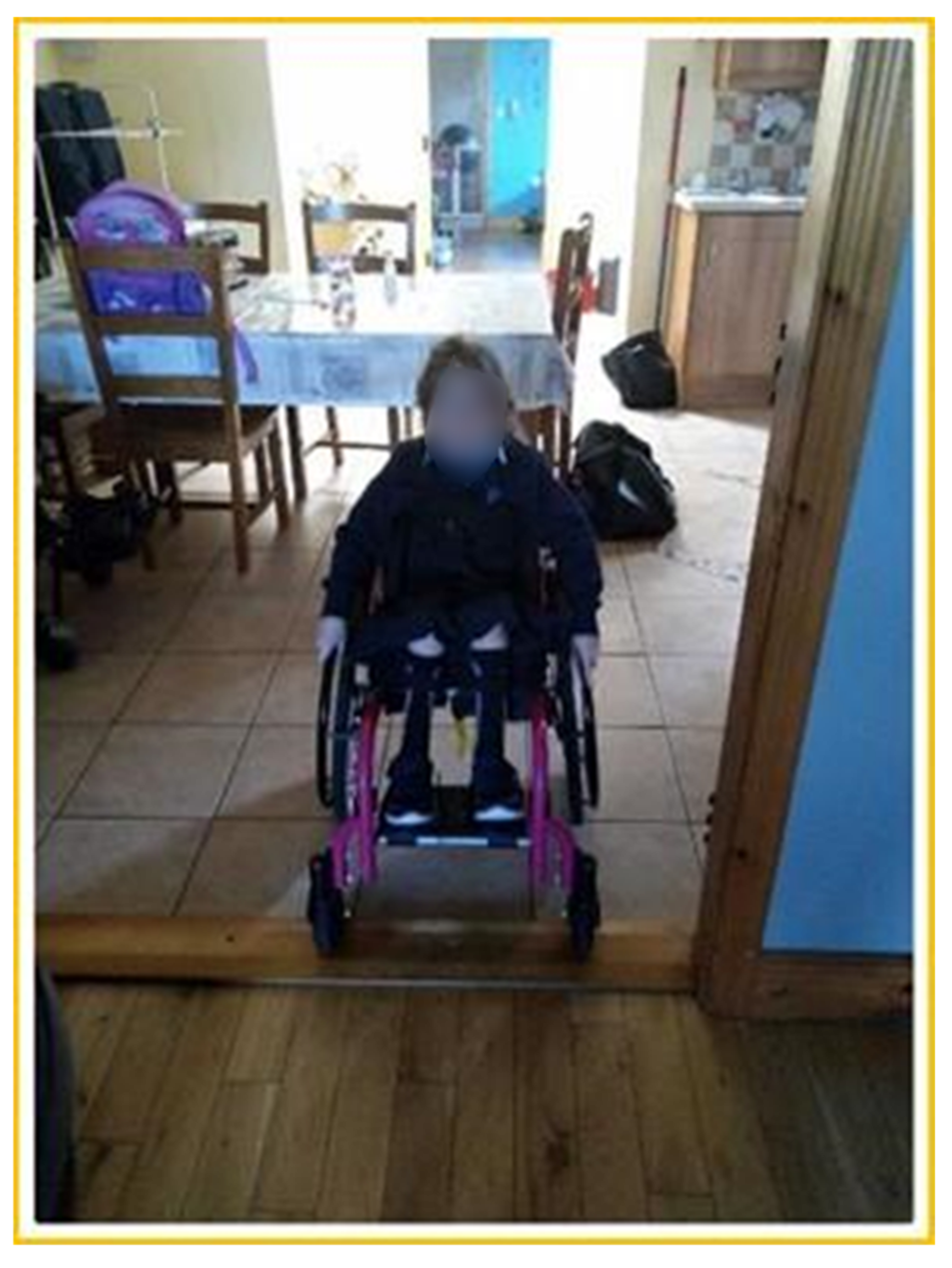
“It will take some time for this habit to be fully adopted as she is used to wheeling herself as fast as her arms allow.”Elaine
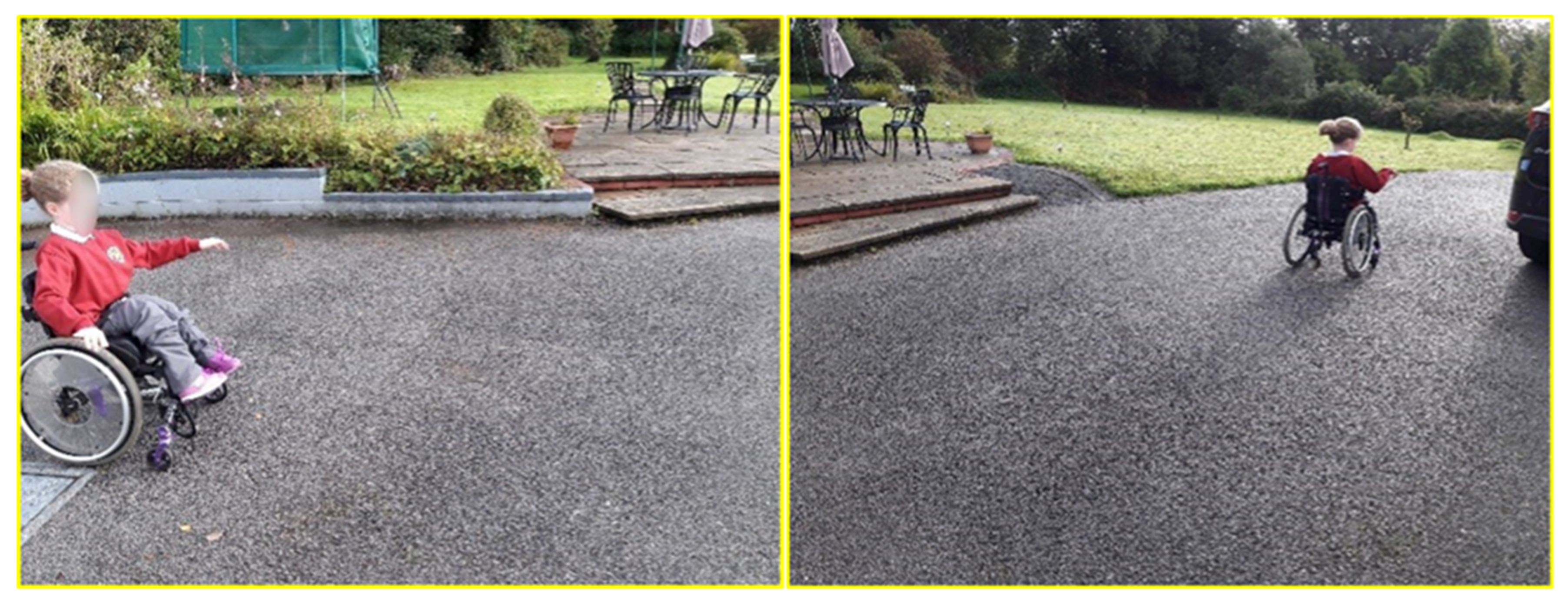
“As long as they are just sitting properly in it, it’s like alright so see you later, off you pop… we have no experience with using a wheelchair or anything, so we were like right… okay, that’s it (after James received his wheelchair).”Aine
“Figure out how to use it yourself”Liz
“The way Jackie was hopping across to the couch was dangerous like, but sure we never knew that.”
Part (1)—“Targeted towards younger children when first given their wheelchair, to inform good habits from the start”Aine
Part (2)—“At a later stage, when children are older and ready to advance their skillset further.”Elaine
4. Discussion
4.1. Interpretation of Findings
4.1.1. A Beneficial Experience
4.1.2. Information Pack Content
4.1.3. Future Recommendations
4.2. Clinical Relevance
4.3. Study Limitations
5. Conclusions
Implications for Rehabilitation
- Wheelchair skills training positively impacted children’s confidence and capacity to use their wheelchairs, with findings that suggest support for early intervention.
- Parent–child relationships were central to skill development, and parents should be both included and involved during training sessions to secure the transfer of skills at home.
- The information pack provided parents with additional support, and this was positively received. Other benefits of the information pack included its potential for continued and future use by parents and children.
Supplementary Materials
Author Contributions
Funding
Institutional Review Board Statement
Informed Consent Statement
Acknowledgments
Conflicts of Interest
References
- Rousseau-Harrison, K.; Rochette, A.; Routhier, F.; Dessureault, D.; Thibault, F.; Côte, O. Perceived impacts of a first wheelchair on social participation. Disabil. Rehabil. Assist. Technol. 2012, 7, 37–44. [Google Scholar] [CrossRef] [PubMed]
- Rousseau-Harrison, K.; Rochette, A. Impacts of wheelchair acquisition on children from a person-occupation-environment interactional perspective. Disabil. Rehabil. Assist. Technol. 2013, 8, 1–10. [Google Scholar] [CrossRef]
- Huang, H.-H. Perspectives on early power mobility training, motivation, and social participation in young children with motor disabilities. Front. Psychol. 2018, 8, 2330. [Google Scholar] [CrossRef] [PubMed]
- ICBDSR. Annual Report 2014. Available online: http://www.icbdsr.org/wp-content/annual_report/Report2014.pdf (accessed on 22 November 2021).
- SBHI. What Is Spina Bifida? 2020. Available online: https://www.sbhi.ie/information/post/what-spina-bifida (accessed on 24 February 2019).
- SBHI. What Is Hydrocephalus? 2020. Available online: https://www.sbhi.ie/information/post/what-hydrocephalus (accessed on 24 February 2020).
- Atta, C.A.M.; Fiest, K.M.; Frolkis, A.D.; Jette, N.; Pringsheim, T.; St Germaine-Smith, C.; Rajapakse, T.; Kaplan, G.G.; Metclalfe, A. Global birth prevalence of Spina Bifida by folic acid fortification status: A systematic review and meta-analysis. Am. J. Public Health 2015, 106, e24–e34. [Google Scholar] [CrossRef] [PubMed]
- NHS. Ventriculomegaly 2020. Available online: https://www.gosh.nhs.uk/conditions-and-treatments/conditions-we-treat/ventriculomegaly/ (accessed on 21 February 2020).
- Pit-ten Cate, I.M.; Kennedy, C.; Stevenson, J. Disability and quality of life in spina bifida and hydrocephalus. Dev. Med. Child Neurol. 2002, 44, 317–322. [Google Scholar] [CrossRef]
- Kahle, K.T.; Kulkarni, A.V.; Limbrick, D.D., Jr.; Warf, B.C. Hydrocephalus in children. Lancet 2016, 387, 788–799. [Google Scholar] [CrossRef]
- Reed, K.L. Quick Reference to Occupational Therapy, 2nd ed.; Pro-Ed, Inc.: Austin, TX, USA, 2001. [Google Scholar]
- Lidal, I.B.; Lundberg Larsen, K.; Hoff, M. 50 years and older—Born with spina bifida: Participation, health issues and physical function. Disabil. Rehabil. 2021, 43, 241–250. [Google Scholar] [CrossRef] [PubMed]
- World Vision. The 8 Steps+, the Role of Community Development Organizations in Providing Holistic Wheelchair Services 2012. Available online: https://www.worldvision.org/wp-content/uploads/The-8Steps-FINAL.pdf (accessed on 22 November 2021).
- Gowran, R.J.; Casey, J.; Daly, J. Utilising a Sustainable Community of Practice Model to build best practice in Wheelchair Provision on the Island of Ireland. In Occupational Therapy without Borders: Integrating Justice with Practice, 2nd ed.; Pollard, N.S.D., Ed.; Elsevier: Amsterdam, The Netherlands, 2017. [Google Scholar]
- Routhier, F.; Kirby, R.L.; Demers, L.; Depa, L.; Thompson, K. Efficacy and retention of the French-Canadian version of the Wheelchair Skills Training Program for manual wheelchair users: A randomized controlled trial. Arch. Phys. Med. Rehabil. 2012, 93, 940–948. [Google Scholar] [CrossRef] [PubMed]
- Morgan, K.A.; Engsberg, J.R.; Gray, D.B. Important wheelchair skills for new manual wheelchair users: Health care professional and wheelchair user perspectives. Disabil. Rehabil. Assist. Technol. 2017, 12, 28–38. [Google Scholar] [CrossRef] [PubMed]
- Kirby, R.L.; Ackroyd-Stolarz, S.A.; Brown, M.G.; Kirkland, S.A.; MacLeod, D.A. Wheelchair-related accidents caused by tips and falls among noninstitutionalized users of manually propelled wheelchairs in Nova Scotia. Am. J. Phys. Med. Rehabil. 1994, 73, 319–330. [Google Scholar] [CrossRef] [PubMed]
- Xiang, H.; Chany, A.M.; Smith, G.A. Wheelchair related injuries treated in US emergency departments. Inj. Prev. 2006, 12, 8. [Google Scholar] [CrossRef] [PubMed]
- Nicholson, J.; Bonsall, M. Powered Mobility for Children under five years of ge in England. Br. J. Occup. Ther. 2002, 65, 291–293. [Google Scholar] [CrossRef]
- Jones, M.A.; McEwen, I.R.; Hansen, L. Use of power mobility for a young child with spinal muscular atrophy. Phys. Ther. 2003, 83, 253–262. [Google Scholar] [CrossRef]
- Fernandes, T. Independent mobility for children with disabilities. Int. J. Ther. Rehabil. 2006, 13, 329–333. [Google Scholar] [CrossRef]
- Kelly, E.H.; Altiok, H.; Gorzkowski, J.A.; Abrams, J.R.; Vogel, L.C. How does participation of youth with spina bifida vary by age? Clin. Orthop. Relat. Res. 2011, 469, 1236–1245. [Google Scholar] [CrossRef] [PubMed]
- Fischer, N.; Church, P.; Lyons, J.; McPherson, A.C. A qualitative exploration of the experiences of children with spina bifida and their parents around incontinence and social participation. Child Care Health Dev. 2015, 41, 954–962. [Google Scholar] [CrossRef] [PubMed]
- Bloemen, M.A.T.; van den Berg-Emons, R.J.G.; Tuijt, M.; Nooijen, C.F.J.; Takken, T.; Backx, F.J.G.; Vos, M.; deGroot, J.F. Physical activity in wheelchair-using youth with spina bifida: An observational study. J. NeuroEng. Rehabil. 2019, 16, 9. [Google Scholar] [CrossRef] [PubMed]
- Anderson, D.; Campos, J.; Witherington, D.; Dahl, A.; Rivera, M.; He, M.; Uchiyama, I.; Barbu-Roth, M. The role of locomotion in psychological development. Front. Psychol. 2013, 4, 440. [Google Scholar] [CrossRef]
- Hoenig, H.; Landerman, L.R.; Shipp, K.M.; George, L. Activity restriction among wheelchair users. J. Am. Geriatr. Soc. 2003, 51, 1244–1251. [Google Scholar] [CrossRef]
- Sutton, M.; Daly, L.; Kirke, P. Survival and disability in a cohort of spina bifida births in Dublin, Ireland. Ir. J. Med. Sci. 2010, 179, 416. [Google Scholar]
- UNCRPD. Committee on the Rights of Persons with Disabilities 2006. Available online: https://www.ohchr.org/EN/HRBodies/CRPD/Pages/ConventionRightsPersonsWithDisabilities.aspx (accessed on 22 November 2021).
- WHO. Guidelines on the Provision of Manual Wheelchairs in Less Resourced Settings 2008. Available online: https://www.who.int/publications/i/item/guidelines-on-the-provision-of-manual-wheelchairs-in-less-resourced-settings (accessed on 22 November 2021).
- Bongade, S.; Jaywant, S.; Yeradkar, R. Effects of specially designed early self-mobility chair on functional independence in a child with myelomeningocele. Indian J. Occup. Ther. 2018, 50, 139–144. [Google Scholar]
- McConachie, H.; Colver, A.F.; Forsyth, R.J.; Jarvis, S.N. Participation of disabled children: How should it be characterised and measured? Disabil. Rehabil. 2006, 28, 1157–1164. [Google Scholar] [CrossRef] [PubMed]
- Gerling, K.; Hicks, K.; Szymanezyk, O.; Linehan, C. Designing interactive manual wheelchair skills training for children. In Proceedings of the 2019 on Designing Interactive Systems Conference, San Diego, CA, USA, 23–28 June 2019; Association for Computing Machinery: New York, NY, USA, 2019; pp. 725–736. [Google Scholar]
- King, G.; Williams, L.; Hahn Goldberg, S. Family-oriented services in pediatric rehabilitation: A scoping review and framework to promote parent and family wellness. Child Care Health Dev. 2017, 43, 334–347. [Google Scholar] [CrossRef] [PubMed]
- King, G.; Law, M.; King, S.; Rosenbaum, P.; Kertoy, M.K.; Young, N.L. A conceptual model of the factors affecting the recreation and leisure participation of children with disabilities. Phys. Occup. Ther. Pediatr. 2003, 23, 63–90. [Google Scholar] [CrossRef]
- Wright, A.; Roberts, R.; Bowman, G.; Crettenden, A. Barriers and facilitators to physical activity participation for children with physical disability: Comparing and contrasting the views of children, young people, and their clinicians. Disabil. Rehabil. 2019, 41, 1499–1507. [Google Scholar] [CrossRef] [PubMed]
- Rosenbaum, P.; Gorter, J.W. The ‘F-words’ in childhood disability: I swear this is how we should think! Child Care Health Dev. 2012, 38, 457–463. [Google Scholar] [CrossRef]
- Sawatzky, B.; Rushton, P.W.; Denison, I.; McDonald, R. Wheelchair skills training programme for children: A pilot study. Aust. Occup. Ther. J. 2012, 59, 2–9. [Google Scholar] [CrossRef]
- Huegel, M.; Otieno, S.; Kenyon, L.K. Validity of the WST and the WST-Q in children with spina bifida: A pilot project. Disabil. Rehabil. Assist. Technol. 2019, 14, 744–750. [Google Scholar] [CrossRef]
- McCann, A.; Hannon-Fletcher, M.; Kerr, D.P. Wheelchair Skills Training Programme for Children: A Pilot Study, Ulster University, Institute of Nursing and Health Research; Posture and Mobility Group: Exeter, UK, 2017. [Google Scholar]
- Mortenson, W.B.; Oliffe, J.L. Mixed methods research in occupational therapy: A survey and critique. OTJR: Occup. Particip. Health 2009, 29, 14–23. [Google Scholar] [CrossRef]
- Tashakkori AaT, C. Sage Handbook of Mixed Methods in Social & Behavioral Research, 2nd ed.; Sage: Los Angeles, CA, USA, 2010. [Google Scholar]
- Macdonald, C. Understanding participatory action research: A qualitative research methodology option. Can. J. Action Res. 2012, 13, 34–50. [Google Scholar]
- Palibroda, B.; Krieg, B.; Murdock, L.; Havelock, J. A Practical Guide to Photovoice: Sharing Pictures, Telling Stories and Changing Communities. 2009. Available online: www.pwhce.ca/photovoice/pdf/Photovoice_Manual.pdf (accessed on 18 July 2019).
- Feldner, H.A.; Logan, S.W.; Galloway, J.C. Mobility in pictures: A participatory photovoice narrative study exploring powered mobility provision for children and families. Disabil. Rehabil. Assist. Technol. 2019, 14, 301–311. [Google Scholar] [CrossRef]
- Walker, M.L. Participatory action research. Rehabil. Couns. Bull. 1993, 37, 2. [Google Scholar]
- McGlanaghy, J.; (University of Limerick, Limerick, Ireland); Gowran, R.J.; (University of Limerick, Limerick, Ireland; University of the Sunshine Coast, Maroochydore, QLD, Australia; Maynooth University, Maynooth, Ireland). Draft Wheelchair Skills Information Pack. Unpublished work. 2019. [Google Scholar]
- Kirby, R.L.; Mifflen, N.J.; Thibault, D.L.; Smith, C.; Best, K.L.; Thompson, K.J.; MacLeod, D.A. The manual wheelchair-handling skills of caregivers and the effect of training. Arch. Phys. Med. Rehabil. 2004, 85, 2011–2019. [Google Scholar] [CrossRef]
- WHO. Wheelchair Service Training Package; Reference manual for Participants; WHO: Geneva, Switzerland, 2012; Available online: https://apps.who.int/iris/bitstream/handle/10665/85776/9789241505765_eng_refmanual.pdf;sequence=4 (accessed on 22 November 2021).
- Liu, H.-Y.T.; Chia, R.-M.; Setiawan, I.M.A.; Crytzer, T.M.; Ding, D. Development of “My Wheelchair Guide” app: A qualitative study. Disabil. Rehabil. Assist. Technol. 2019, 14, 839–848. [Google Scholar] [CrossRef] [PubMed]
- Campbell, K.; Amare, N.; Kane, E.; Manning, A. Plain-style preferences of US professionals. IEEE Trans. Prof. Commun. 2017, 60, 401–411. [Google Scholar] [CrossRef]
- Mason, J. Mixing methods in a qualitatively driven way. Qual. Res. 2006, 6, 9–25. [Google Scholar] [CrossRef]
- Kitzinger, J. Qualitative Research: Introducing focus groups. BMJ 1995, 311, 299. [Google Scholar] [CrossRef] [PubMed]
- Carpenter, C.; Suto, M. A Practical Guide, Qualitative Research for Occupational and Physical Therapists, 1st ed.; Blackwell Publishing: Oxford, UK, 2008. [Google Scholar]
- Krueger, R.A. Designing and Conducting Focus Group Interviews. 2002. Available online: https://www.eiu.edu/ihec/Krueger-FocusGroupInterviews.pdf (accessed on 25 April 2019).
- Hergenrather, K.C.; Rhodes, S.D.; Cowan, C.A.; Bardhoshi, G.; Pula, S. Photovoice as community-based participatory research: A qualitative review. Am. J. Health Behav. 2009, 33, 686–698. [Google Scholar] [CrossRef] [PubMed]
- Krueger, R.A. Developing Questions for Focus Groups; Sage: London, UK, 1998. [Google Scholar]
- Kirby, R.L.; Swuste, J.; Dupuis, D.J.; MacLeod, D.A.; Monroe, R. The Wheelchair Skills Test: A pilot study of a new outcome measure. Arch. Phys. Med. Rehabil. 2002, 83, 10–18. [Google Scholar] [CrossRef]
- MacPhee, A.H.; Kirby, R.L.; Coolen, A.L.; Smith, C.; MacLeod, D.A.; Dupuis, D.J. Wheelchair skills training program: A randomized clinical trial of wheelchair users undergoing initial rehabilitation. Arch. Phys. Med. Rehabil. 2004, 85, 41–50. [Google Scholar] [CrossRef]
- Kirby, L.R.; Best, K.L.; Boyce, J.; Cowan, R.; Giesbrech, E.; Kenyon, L.K.; Koontz, A.; MacKenzie, D.; Mortenson, B.; Parker, K.; et al. Wheelchair Skills Program Manual Version 5.0 2019. Available online: https://wheelchairskillsprogram.ca/wp-content/uploads/WSP-Manual-version-5.0-approved-version.3.pdf (accessed on 22 November 2021).
- Kirby, R.L. Wheelchair Skills Assessment and Training; CRC Press: Boca Raton, FL, USA, 2016. [Google Scholar]
- Keeler, L.; Kirby, R.L.; Parker, K.; McLean, K.D.; Hayden, J.A. Effectiveness of the Wheelchair Skills Training Program: A systematic review and meta-analysis. Disabil. Rehabil. Assist. Technol. 2019, 14, 391–409. [Google Scholar] [CrossRef] [PubMed]
- WhatsApp. Privacy Policy 2019. Available online: https://www.whatsapp.com/legal/#privacy-policy (accessed on 20 June 2019).
- Krueger, R.A. Moderating Focus Groups; Sage: London, UK, 1998. [Google Scholar]
- Braun, V.; Clarke, V. To saturate or not to saturate? Questioning data saturation as a useful concept for thematic analysis and sample-size rationales. Qual. Res. Sport Exerc. Health 2021, 13, 201–216. [Google Scholar] [CrossRef]
- Carter, N.; Bryant-Lukosius, D.; DiCenso, A.; Blythe, J.; Neville, A.J. The use of triangulation in qualitative research. Oncol. Nurs. Forum. 2014, 41, 545–547. [Google Scholar] [CrossRef] [PubMed]
- Etherington, K. Becoming a Eflexive Researcher Using Ourselves in Research; Jessica Kingsley Publishers: London, UK, 2004. [Google Scholar]
- Vaismoradi, M.; Jones, J.; Turunen, H.; Snelgrove, S. Theme development in qualitative content analysis and thematic analysis. J. Nurs. Educ. Pract. 2016, 6, 100–110. [Google Scholar] [CrossRef]
- Morgan, D.L. Qualitative content analysis: A guide to paths not taken. Qual. Health Res. 1993, 3, 112–121. [Google Scholar] [CrossRef]
- Braun, V.C.; Clarke, V. Successful Qualitative Research: A Practical Guide for Beginners, 1st ed.; Sage: Los Angeles, CA, USA, 2013. [Google Scholar]
- Braun, V.; Clarke, V. Using thematic analysis in psychology. Qual. Res. Psychol. 2006, 3, 77–101. [Google Scholar] [CrossRef]
- Edwards-Jones, A. Qualitative Data Analysis with Nvivo, 2nd ed.; Sage: Los Angeles, CA, USA, 2014. [Google Scholar]
- Limerick Uo. Research Ethics, Education and Health Science. 2019. Available online: https://www.ul.ie/ehs/research-ethics (accessed on 20 March 2019).
- Lutabingwa, J.; Nethonzhe, T. Ethical Issues in Social Research 2017. Available online: https://vdocuments.site/research-ethics-59120f4a0277b.html (accessed on 22 March 2019).
- Punch, K. Developing Effective Research Proposals, 2nd ed.; Sage: London, UK, 2006. [Google Scholar]
- Hennink, M.; Hutter, I.; Bailey, A. Qualitative Research Methods; Sage: London, UK, 2011. [Google Scholar]
- Baksjøberget, P.E.; Nyquist, A.; Moser, T.; Jahnsen, R. Having fun and staying active! Children withdisabilities and participation in physical activity: A Follow-Up Study. Phys. Occup. Ther. Pediatrics 2017, 37, 347–358. [Google Scholar] [CrossRef][Green Version]
- Giesbrecht, E.M.; Miller, W.C.; Eng, J.J.; Mitchell, I.M.; Woodgate, R.L.; Goldsmith, C.H. Feasibility of the enhancing participation in the community by improving wheelchair Skills (EPIC Wheels) program: Study protocol for a randomized controlled trial. Trials 2013, 14, 350. [Google Scholar] [CrossRef]
- Chen, W.-Y.; Jang, Y.; Wang, J.-D.; Huang, W.-N.; Chang, C.-C.; Mao, H.-F.; Wang, Y.-H. Wheelchair-related accidents: Relationship with wheelchair-using behavior in active community wheelchair users. Arch. Phys. Med. Rehabil. 2011, 92, 892–898. [Google Scholar] [CrossRef]
- Rice, L.A.; Sung, J.; Peters, J.; Bartlo, W.D.; Sosnoff, J.J. Perceptions of fall circumstances, injuries and recovery techniques among power wheelchair users: A qualitative study. Clin. Rehabil. 2018, 32, 985–993. [Google Scholar] [CrossRef]
- European Commission. Green Paper on Mobile Health (“mHealth”); European Commission: Brussels, Belgium, 2014. [Google Scholar]
- Silva, B.M.C.; Rodrigues, J.J.P.C.; de la Torre Díez, I.; López-Coronado, M.; Saleem, K. Mobile-health: A review of current state in 2015. J. Biomed. Inform. 2015, 56, 265–272. [Google Scholar] [CrossRef] [PubMed]
- Giesbrecht, E.M.; Miller, W.C.; Jin, B.T.; Mitchell, I.M.; Eng, J.J. Rehab on wheels: A pilot study of tablet-based wheelchair training for older adults. JMIR Rehabil. Assist. Technol. 2015, 2, e3. [Google Scholar] [CrossRef] [PubMed]
- Broderick, J.; TDevine ELanghans, A.; Lemerise, J.; Lier, S.; Harris, L. Designing Health Literate Mobile Apps; Institute of Medicine of the National Academies: Washington, DC, USA, 2014. [Google Scholar]
- Sol, M.E.; Verschuren, O.; de Groot, L.; de Groot, J.F.; Fit-For-the-Future!-consortium. Development of a wheelchair mobility skills test for children and adolescents: Combining evidence with clinical expertise. BMC Pediatr. 2017, 17, 51. [Google Scholar] [CrossRef] [PubMed]
- Willis, C.; Girdler, S.; Thompson, M.; Rosenberg, M.; Reid, S.; Elliot, C. Elements contributing to meaningful participation for children and youth with disabilities: A scoping review. Disabil. Rehabil. 2017, 39, 1771–1784. [Google Scholar] [CrossRef]
- Groff, D.; Kleiber, D. Exploring the identity formation of youth involved in an adapted sports program. Ther. Recreat. J. 2001, 35, 318–332. [Google Scholar]
- Bovend’Eerdt, T.J.; Botell, R.E.; Wade, D.T. Writing SMART rehabilitation goals and achieving goal attainment scaling: A practical guide. Clin. Rehabil. 2009, 23, 352–361. [Google Scholar] [CrossRef]
- Anderson, D.M.; Wozencroft, A.; Bedini, L.A. Adolescent girls’ involvement in disability sport: A comparison of social support mechanisms. J. Leis. Res. 2008, 40, 183–207. [Google Scholar] [CrossRef]
- Brunton, L.K. Clinicians are the missing link to sustainable community-based physical activity participation for children with disabilities. Phys. Occup. Ther. Pediatrics 2017, 37, 359–361. [Google Scholar] [CrossRef]
- Calhoun, C.; Schottler, J.; Vogel, L. Recommendations for Mobility in Children with Spinal Cord Injury. Top. Spinal Cord Inj. Rehabil. 2013, 19, 142–151. [Google Scholar] [CrossRef]
- Rousseau-Harrison, K.; Rochette, A.; Routhier, F.; Dessureault, D.; Thibault, F.; Côte, O. Impact of wheelchair acquisition on social participation. Disabil. Rehabil. Assist. Technol. 2009, 4, 344–352. [Google Scholar] [CrossRef]
- Daoust, G.; Rushton, P.W.; Racine, M.; Leduc, K.; Assila, N.; Demers, L. Adapting the Wheelchair Skills Program for pediatric rehabilitation: Recommendations from key stakeholders. BMC Pediatr. 2021, 21, 103. [Google Scholar] [CrossRef] [PubMed]
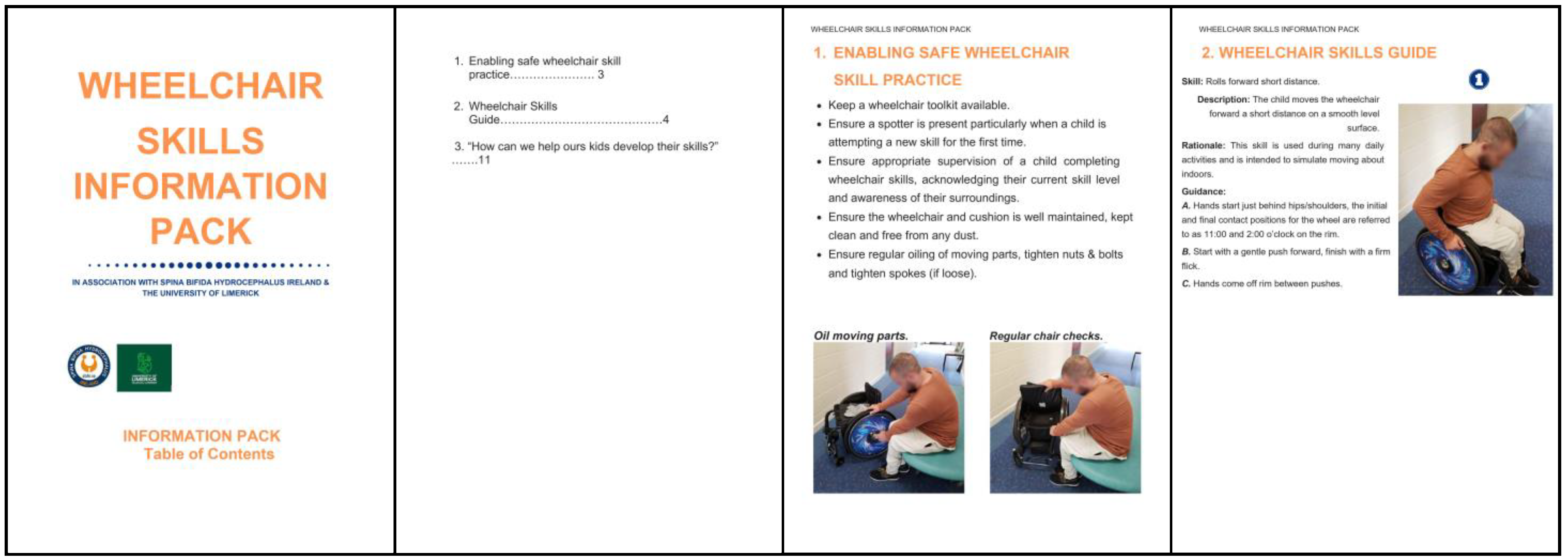
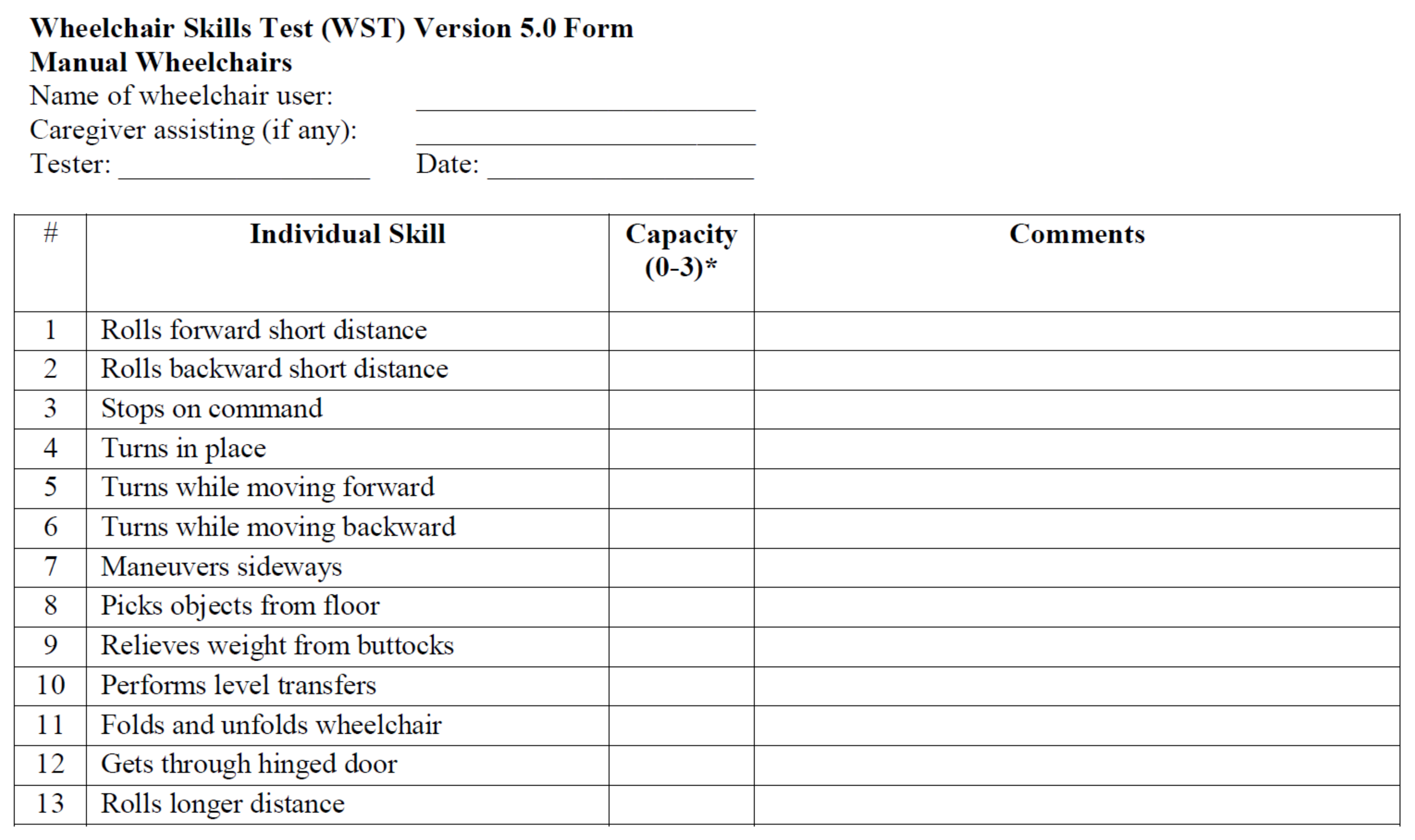

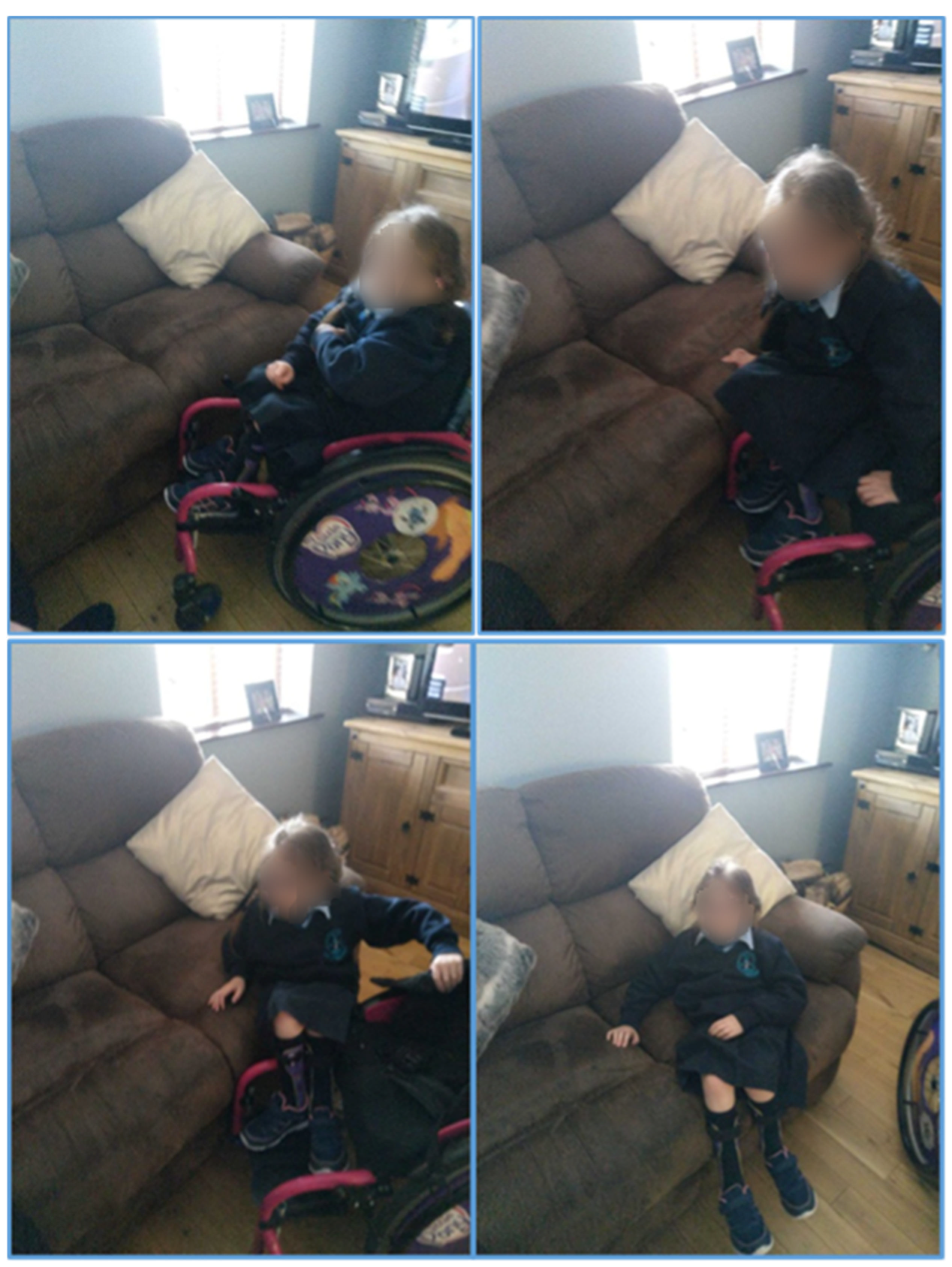
| Training Program | Activities |
|---|---|
|
Day 1 Baseline information |
|
|
Day 2 Skills training | Skills Taught
|
|
Day 3 Skills training | Skills Taught
|
|
Day 4 Training evaluation |
|
| Focus Group 1 |
|---|
|
| Focus Group 2 |
|
| Additional Focus Group Questions |
|
| Thematic Analysis (TA) Stage | Details |
|---|---|
| 1. Familiarization and data immersion | Transcripts were read several times, and a list of ideas about the dataset was compiled. |
| 2. Generating initial codes | The dataset was coded, with a focus on codes that addressed the research question and objectives. |
| 3. Searching for themes | Candidate themes were derived—concepts, topics and issues were highlighted, and each code was revisited to identify similarities and overlap that could be used as a central organizing concept. |
| 4. Reviewing themes | Codes selected for each theme were revisited to ensure representativeness. The datasets were re-read to ensure selected themes represented the entire dataset as it relates to the research aim and objectives. |
| 5. Naming and defining themes | Each theme was named and defined by outlining its key features and what is specific to its data. |
| 6. Writing the results | Under each theme, extracts from the data were selected to best illustrate the key points that represented each theme. The results were written using an analytical approach, in which content is closely tied with the extracts presented. |
| Pseudonym Names (Parent/s) | Pseudonym Names (Child) | Age of Child at Time of Program (Years) |
|---|---|---|
| Elaine | Sally | 8 |
| Emily | Joanne | 5 |
| John and Liz | Jackie | 7 |
| Aine | James | 2.5 |
| mean (min–max) | 5.6 (2.5–8) | |
| Ethnicity | ||
| Irish | 4 | |
| Other | 0 | |
| Sex | ||
| Male | 1 | |
| Female | 3 | |
| Mobility Aid Use (1+ aids for some children) | ||
| Wheelchair (full-time) | 3 | |
| Wheelchair (part-time) | 1 | |
| Walker (full-time) | 0 | |
| Walker (part-time) | 1 | |
| Braces (full-time) | 1 | |
| Braces (part-time) | 0 | |
| Code | Theme | Frequency of Code | % Frequency | Illustrative Quotes |
|---|---|---|---|---|
| T1 | A beneficial experience | 18 | 60% | “Everything that ye have done and the advice given has made such a difference for us, for Joanne” [Emily] “Knowing how to do things the right way to make life easier on themselves” [John] |
| T2 | Information pack contents | 3 | 10% | “…I think it is a good book. The photos are especially useful…” [John] “We found this course so helpful making life easier for Joanne and us” [Emily] |
| T3 | Future Recommendations | 9 | 30% | “In time it could be expanded to include video links to demos” [Aine] “Video tutorials of the skills that were stored online somewhere/app” [Elaine] |
| Post-Wheelchair Skills Training Program | Thematic Overview |
|---|---|
| (T1) Parents’ Perspectives on how Training Influenced Children’s Daily Participation |
|
| (T2) Beneficial Aspects of Program Delivery |
|
Publisher’s Note: MDPI stays neutral with regard to jurisdictional claims in published maps and institutional affiliations. |
© 2022 by the authors. Licensee MDPI, Basel, Switzerland. This article is an open access article distributed under the terms and conditions of the Creative Commons Attribution (CC BY) license (https://creativecommons.org/licenses/by/4.0/).
Share and Cite
Gowran, R.J.; Collins, M.B.; McGlanaghy, J.; Shanahan, E.; Cleary, Y. Wheelchair Skills Education and Training for Children with Spina Bifida and/or Hydrocephalus and Their Parents: A Pilot Study. Disabilities 2022, 2, 96-118. https://doi.org/10.3390/disabilities2010009
Gowran RJ, Collins MB, McGlanaghy J, Shanahan E, Cleary Y. Wheelchair Skills Education and Training for Children with Spina Bifida and/or Hydrocephalus and Their Parents: A Pilot Study. Disabilities. 2022; 2(1):96-118. https://doi.org/10.3390/disabilities2010009
Chicago/Turabian StyleGowran, Rosemary Joan, Marion B. Collins, Joanne McGlanaghy, Ellen Shanahan, and Yvonne Cleary. 2022. "Wheelchair Skills Education and Training for Children with Spina Bifida and/or Hydrocephalus and Their Parents: A Pilot Study" Disabilities 2, no. 1: 96-118. https://doi.org/10.3390/disabilities2010009
APA StyleGowran, R. J., Collins, M. B., McGlanaghy, J., Shanahan, E., & Cleary, Y. (2022). Wheelchair Skills Education and Training for Children with Spina Bifida and/or Hydrocephalus and Their Parents: A Pilot Study. Disabilities, 2(1), 96-118. https://doi.org/10.3390/disabilities2010009








